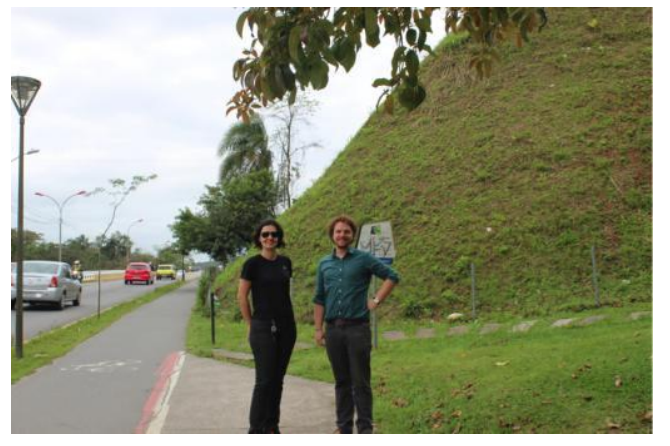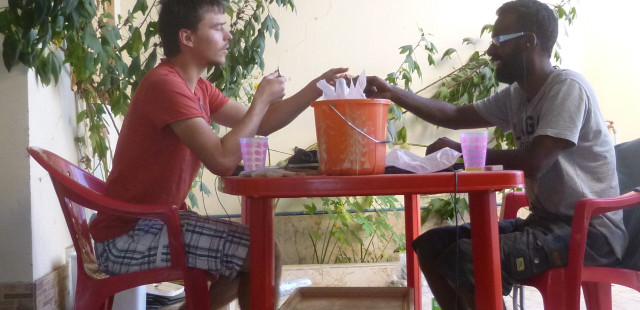I am a PhD student in the DISPERSE-Project at the University of York. One of the project’s main aims is to analyse the coastal settlements in Arabia during the early Neolithic. My PhD “Farasan Islands: An Isotope Study” focuses on the over 3000 shell middens on the Farasan Islands, Saudi Arabia. It is the most elaborate site of coastal exploitation on the Arabian coast, with the highest concentration of shell midden sites in the world. The middens are exceptional, especially when compared to the small number of prehistoric coastal sites on the Arabian mainland located 40 km further east. They accumulated over a period from 6500 to around 4000 cal BP and their different constellations of sites and sea level suggest a change in the environment as well as exploitation intensity.
The actual occupation duration of individual middens is still a part of ongoing research as there are many different stages of occupation and clusters of middens that align with different palaeoshorelines. The shell middens range from small, deflated clusters to 6 m high mounds of tightly packed shell. Mostly there is little or no fine-grained sediment present and most layers are clast-supported. 90% of the excavated shell middens contain high amounts of Strombus fasciatus shells.
My research deals with the accumulation of these S. fasciatus shells during this time of intense exploitation. I am trying to evaluate the possibility of using the isotopic records in S. fasciatus shells to reconstruct the water temperature of the shells environment when it was alive, to find out about the season of death. Ultimately this seasonality study will give me an insight into exploitation patterns and accumulation rates of the sites.
The great number of sites suggests an intense exploitation that can be almost called industrialised. However, by not actually knowing how much of the shell deposit is being used at a time, it is not clear if all accumulated at once by a large island population or if it accumulated slowly but steadily by a much smaller number of people. It is likely that the truth is somewhere in between but how this is related to site distribution, archaeological finds, burials, environmental change and possibly the change of social structures, is yet to be found out.
To verify S. fasciatus as a seasonality proxy, I collected modern shells at different times of the year and sampled the most recent growth increments to compare the isotopic composition to the temperature of the water at the time of collection. I found that the isotopic composition is strongly correlated to the water temperature and can be used to calculate the hypothetical temperature with an error of less than 1°C.
Additionally to the isotopic analysis of the shell. I also carried out analyses using laser ablation to look at the change in elemental composition with the change in temperature. Laser Induced Breakdown Spectroscopy (LIBS) was used to measure the Mg/Ca ratio of the shell aragonite with promising results. Because LIBS is faster and more costeffective, we made the first step towards a mass production of seasonality and climate data from archaeological shells. Using the grant awarded by the BFSA, I was able to present my research at the conference of the International Council for Archaeozoology in San Rafael, Argentina in September 2014. The presentation was a success and was well received. The immediate result was the invitation to an additional conference in Tubarão, Brazil, the I Seminário Internacional de Arqueologia Subaquática (First International Seminar of Underwater Archaeology) hosted by Deisi Scunderlick Eloy de Farias at the beginning of October. Here I was able to present the research to an archaeological community that has been heavily influenced by shell midden research and had a great interest in the Arabian shell midden sites as well as the tools and methods used in Saudi Arabia. An additional invitation was followed by the Museum for Shell Middens in Joinville, Brazil to give another talk and foster relationships for future international projects comparing Brazil, that has the largest shell middens, and Saudi Arabia, that has the area with the most concentrated shell middens in the world. To conclude, the grant awarded by the BFSA made it possible to not only present my research at a very important conference to an international community of archaeologists but also laid the foundation for two additional presentations and future research with shell midden specialists.
Photo: Shell midden specialist Beatriz Ramos da Costa and me in front of shell mound “Morro do Ouro” in Joinville.




